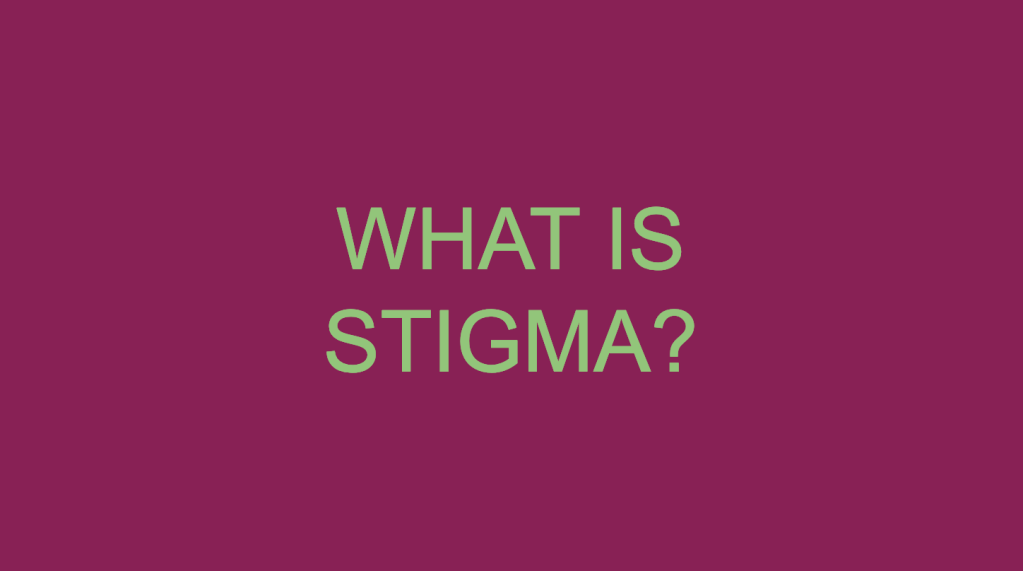
People act weird around your classmate. Julia is bright, attractive, and fun to hang out with. Around the whole school, she used to be pretty popular; so why does it seem recently like people avoid her?
Thinking back, all this might have started a month ago, when she started hanging out with the kids in the Gay-Straight Alliance (GSA). She told you then that she was bisexual, and although her “secret” was safe with you, that info became more public. And ever since, people have made a ton of assumptions about her.
Straight girls avoid her because they think she’ll hit on them. Most guys assume she sleeps around and probably has an STD. The jocks and preps avoid her since she hangs out with the “weird” kids now.
Unfortunately, your classmates have placed a stigma on Julia.
What is stigma?
The leading social theorist on stigma, Erving Goffman, described stigma as something that “spoils” a person’s identity, some information that, once added to an interaction, makes the person who has it seem “bad” in some way. Stigma can make interactions awkward, and reactions to it often look like prejudice.
A key feature of stigma is that it is not something we are born with; it is something we receive from other people when we interact with them. Despite our best intentions, all of us have likely attributed stigma to someone else, and a whole lot of us have likely been on the receiving end of stigmatization. As humans, we tend to be most comfortable when we know exactly who someone else is in relation to us, and stigma can make that categorization easier.
How do people become stigmatized?
Even though stigma is received from other people in interactions, the things we tend to stigmatize in people are drawn from our culture. Culture has the ability to create stereotypes, and no one within a culture is immune to their impacts. These stereotypes tell us things like different races are morally better or worse than others, or that pretty people are smart, or that women are too emotional.
Stigmatized characteristics tend to fall into three main categories – physical stigmas (stigmas about a person’s body), character stigmas (stigmas about a person’s actions or morality), and tribal stigmas (stigmas about a person’s associations, like their family, friends, religious group, gender category, etc.). In a given situation, these categories might overlap.
Sometimes, we attribute stigma to people at first sight of them. It could be as mundane as seeing a person walk by wearing a “hooker-dress” and assuming they are promiscuous. Or, it could be tied to one’s identity of being a woman, and assuming they are bad at math. Goffman calls people who have stigmas based on things we can see (or think we can see) discredited people.
More often, we might learn something about someone later-like in Julia’s case-that makes us see a stigma where there was not a visible one before. Goffman calls people with stigmas that are not immediately visible discreditable people; they might not be stigmatized right away, but they could be later on when the “secret” gets out.
What impact does stigma have on individuals and communities?
As you may have come to the conclusion yourself, stigma’s impacts are major. Some of the ways people are impacted by stigma emerges in systemic discrimination: those big “isms” people face in our society. These include, but are not limited to:
- Systemic Body Stigma – fat stigma/fatphobia, ableism, “pretty privilege,” racism.
- Systemic Character Stigma – negative moral stereotypes related to mental illness, race, women with STDs, poverty.
- Systemic Tribal Stigma – racism, sexism, LGBTQ+ phobia, Islamophobia, anti-Semitism.
As budding scholars, we believe stigma is not only an interesting topic, but also an important theory (an idea on which we have and can build knowledge) to study with practical implications for how we work to change society. So, we decided to take the next three posts to present to you all our “Stigma Mini Series!!” *scoot scoot*
This series will look at:
- Fat phobia through the lens of diagnostic stigma.
- Juvenile delinquency through the lens of self-fulfilling prophecies.
- Mental health through the lens of labeling.
We hope you enjoy this journey of learning about stigma as much as we do! In the comments below, let us know your initial thoughts and any questions that might have come up for you.
References:
Goffman, Erving. 1963. Stigma: Notes on the Management of Spoiled Identity. Touchstone.
